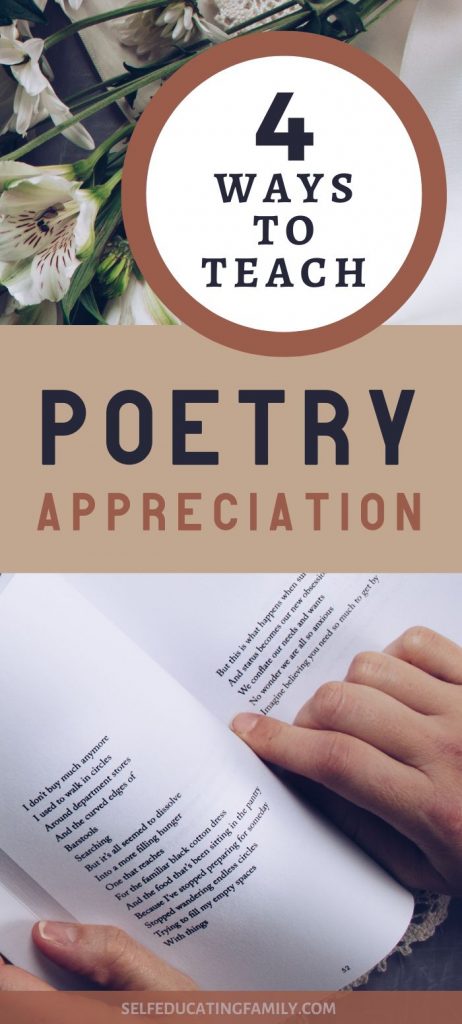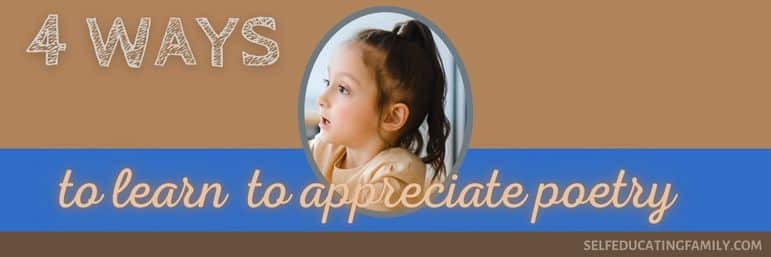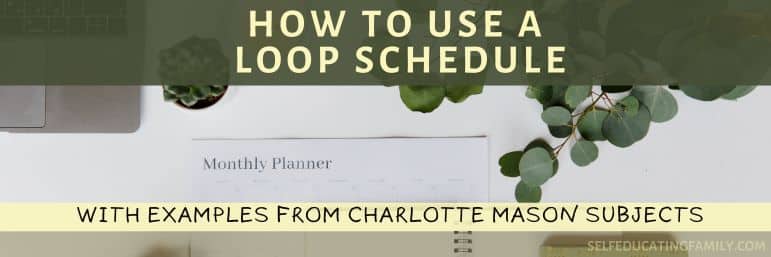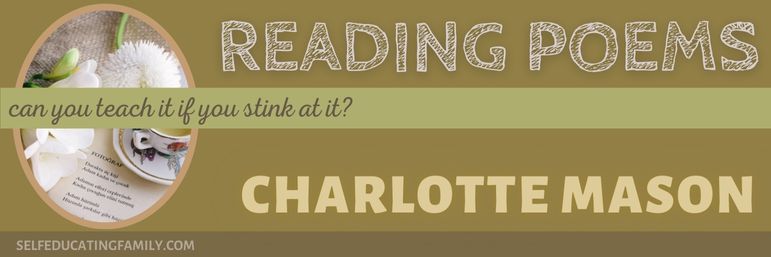What’s inside: Four ways to incorporate poetry appreciation into your day! If you struggle with boring lessons or resistance, your homeschooling day can be uplifted with simple tricks, short lessons, and bringing some beauty into your kid’s lives. Poetry appreciation takes 5 minutes a day and can last a lifetime in your kids’ hearts.
This post may contain affiliate links. If you find my content valuable and make a purchase through one of my links, I will earn a commission at no cost to you, which helps me keep this blog going so I can help you even more! I recommend products I trust and/or use myself, and all opinions I express are my own. Read the full disclaimer here.
Poetry appreciation
Adding poetry appreciation to a homeschooling day turned out to be much easier than I had imagined. Charlotte Mason thought poetry studies were essential.
If you are like me and leery of Poetry, don’t let past negative experiences influence how you think it has to be taught.
First, be sure you read aloud well. Appreciating poetry relies on hearing well-crafted words, even if it is only in your mind. Did you know that ASL Poetry (American Sign Language) is performed and “must be seen to appreciate the full meaning,” according to VeryWellHealth?
Imagining the words in your brain is the path to appreciating poetry.
It’s like Shakespeare – it’s great if you can read it, but the best way to enjoy a Shakespeare play is to see it.
So Step 1 in poetry appreciation is to learn to read aloud well.
Getting started
Once you have a good reader in the family, you need to incorporate reading a poem or two into your day if you are trying to add poetry studies to your homeschooling.
Here are four ways to approach poetry studies that can keep it simple and help you get started:
- Morning Basket Read Alouds
- Using during Copywork
- Asking for a Narration now and then
- Using particular poems as Recitations
Reading during Family time: the Morning Basket
“Morning Basket” is an expression to describe family time to learn together. In general, morning basket may include family read-alouds, hymns, and folk songs, recitations, and any of the more formal subjects you are all working on together.
It will look slightly different for each family, but morning basket can include a literal basket of books that you are using together as a family.
Remember to keep in mind that you always want to be reading living books – books with beautiful words or ideas that engage the mind. Poetry can be a part of that.
“It doesn’t matter what you call it, the practice is still the same. Everybody’s coming together, everybody’s learning together all at the same time.”
Pam Barnhill of Your Morning Basket
For Poems, Start Small
If you have young children, definitely start with shorter, easier, fun poetry that may thrill little people. When you have older kids also, keep the littles involved with poetry read-alouds. It can be a great way to engage everyone. Bigger kids can practice their vocal variety on an absorbing poem.
For instance, Robert Louis Stevenson’s A Child’s Garden of Verses has a poem called Looking Forward.
LOOKING FORWARD
When I am grown to man's estate I shall be very proud and great And tell the other girls and boys Not to meddle with my toys.
Ok, that’s just fun. And it takes less than 30 seconds to read out loud. If you want an adventurous poem from the same book, try The Pirate.
Put A Child’s Garden of Verses in your morning basket if you don’t have a specific poet that you are studying this semester. As your family gets better at reading and listening to poetry (or if you have older children who are starting to appreciate poetry), you might want to advance to studying one poet a semester.
Ambleside online suggests different poets for each age/grade, but it’s ok to just keep the same poet for the whole family until your children are big enough to appreciate poetry on their own—when they can read the poems to themselves and “hear it” in their heads. You will be able to tell this from a narration (see below). Then they might be able to bring a recitation to morning basket time. (Also see below.)
Copywork
Copywork is the next natural progression in poetry appreciation.
Your sources of copywork should always be great authors of living material. The copywork itself must put together words and thoughts in an engaging way, even though the child is simply copying the words.
Copywork is more than penmanship practice – it should be the teacher of grammar and what makes great literature. By repeatedly using great literature as a source of copywork, grammar and composition seep into the child’s mind and as they begin to do written narrations, good grammar and composition begin to grow naturally.
TIP: Do not make a child copy every poem they hear. You want them to learn to like the poems first. Also, do not start copywork until formal lessons begin after age 6 or so. If the child asks to use a particular poem for copywork, then, by all means, go for it.
Note on spelling
Side note: Sometimes the natural progression of what happens from using copywork as an educational method applies to spelling also, but I’m not a good one to ask about that. While I am a natural speller, none of my children were, not even the voracious reader. Go figure.
Takeaway: Children are persons. Figure out each child.
Also, remember to let the child select the material for copywork if possible. As I said before, if they ask for a particular piece, that’s fabulous.
Tip on the tip: Know your kids – beware of certain children who ask for the absolute SHORTEST piece of copywork possible.
Copywork and poetry
In short, poetry is ideally suited to copywork.
- It comes in varying lengths.
- Carefully chosen words are foundational to poetry.
- It’s easy to find separate pieces of copywork instead of searching for a good quote from the entire body of literature.
- It’s a great variation for grammar forms – by changing up the form of what is copied, a child can get exposure to a large variety of how words are written.
- In this way, it’s similar to listening to read-alouds (or listening to audiobooks) that are above your reading “grade level” – you can be exposed to words that you haven’t seen before and thus expand your vocabulary.
Freebies for you
Check out 9 summer-themed quotes from poetry at this post.
There’s another short freebie of poetry copywork done for you if you want to try 4 poems from Robert Louis Stevenson’s A Child’s Garden of Verses over in the Freebies Library. If you are a current subscriber to the newsletter, then you know the secret password to get in. Look for it under Copywork.
If you’d like the freebie and you aren’t signed up for the newsletter, sign up below, and I’ll send you a copy of the another copywork poem: this one by Edgar Guest called Gratitude. When you sign up all of the copywork in the Freebies Library will be available to you.
Sign up to Get the Freebie
Free Gratitude Copywork
When you sign up for the newsletter, you can download the Gratitude Poem by Edgar Guest copywork for free!
SelfEducatingFamily.com needs the contact information you provide to us to contact you about our products and services. You may unsubscribe from these communications at anytime. See our privacy policy for terms and conditions and to learn how we protect your data.
Narration
Next in the natural progression of poetry applications come narration.
Like copywork, you don’t want to be narrating every poem you read. Reading and listening needs to be enjoyed, especially with poems. Don’t be that 7th grade teacher who demanded a 5-page analysis of everything you read!
Less is more in this case. If you want to see what your kids think of a poem that you just read, simply pause at the end. See if any responses come naturally. If they don’t and you’re due for a narration, use open ended questions.
With narration, it’s very hard to do, but you want to allow the thoughts to come without too much prompting. So no interrogations with umpteen questions, no multiple choice quizzes, no yes/no questions.
Narration is designed to make the child use his brain. According to Narration tips from The Parent’s Review by Stanley Boardman, Headmaster of the Council School in Bishop’s Cleeve, by teaching too much, “the child undoubtedly arrives at a point at which the teacher wishes him to arrive, but he has not exercised his “mental muscles” in getting there. He has had a lift by the way.”
He also said that narration “is not an act of verbal memory. It is a process which makes all the difference between a child knowing a thing and not knowing it. … It is the method whereby the child assimilates what he reads… Narration ensures a vision of the whole in orderly sequence.”
With that in mind, here are some tips for narration.
Narration Tips
Try This
Use open-ended prompts, if any are necessary.
- Tell me what you heard/read.
- What did you think?
- What comes next?
Not This
Don’t use yes/no questions, be too specific, or talk too much.
- What did the boat symbolize?
- Did you like this poem? or
I think “X”. Do you agree? - What happened after “X”?
Why?
Let them assimilate the knowledge. They have to do the work.
- Too specific
- Yes/no is not open-ended – it’s too specific
- You don’t want to give the narration yourself. You want to see if the child has absorbed the material.
For more troubleshooting narration, hop over to the freebie library for a free Narration Troubleshooting Guide. It’s under Guides.
Recitation
As a final way to incorporate poetry, you can add poems to your recitations.
Recitation means to stand in front of other people and say the selection from memory. Yes, recitation involves memorization. And yes, it’s a good candidate for the family time of morning basket.
Memorizing is also good for brains. Both old and young. According to the Cleveland Clinic Center for Brain health, reciting nursery rhymes helps little brains to learn language patterns. And old people can stave off cognitive decline with memorization. Memorizing is not a waste of time.
Poems and recitation
Recitation can happen if you’ve memorized a poem after reading it, practicing it aloud, maybe using it for copywork or narrating the gist of it.
This progression: listening, reading, speaking, copying the words, narrating what you remember, allows you to finally recite it in front of other people.
One last thought
I hope this helps you on your journey to appreciating poetry.
If you are reluctant, or you have a child who is objecting to poetry appreciation, try different subject matter. For instance, maybe your child “hates” poetry but loves The Hobbit. There are some fun poems in Tolkien’s writings. Try that.
Keep trying until you find something you can appreciate.
Keep Learning
Get my Free Curated Poetry QuickStart Guide
Click below to go to my ItList “Add Poetry to Your Day: Quick Start Guide”. It’s free and it will help you get started with Poetry Studies.
Related articles:







